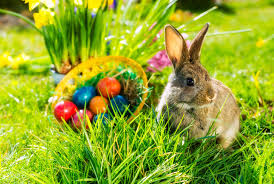Where did the Easter Bunny originate, since Easter is a Christian religious celebration of the resurrection of Jesus from the Crucifixion? And how did the Easter Bunny become associated with this holy day?

Rabbits are common and found on every continent except Antarctica. Rabbits are also prolific breeders, especially in the spring. As a result, rabbits have long been associated with spring and with new life.
My curiosity got the better of me and I began to do some research. This research took me in two directions at the beginning, but I found that the two avenues finally did come together in the end.
Greek Goddess Eostre
I first stumbled upon the Greek Goddess Eostre, also known as Eastre. She was a goddess who was worshiped in the spring. And she symbolized the rebirth of the land with springtime. She was associated with fertility and legend says she changed her pet bird into a rabbit to amuse the children. This rabbit brought brightly colored eggs to the children as gifts. Over time the tradition of the feasts in honor of Eostre eventually died but was replaced by the Christian celebration of the resurrection of Jesus.
My research then took me into the early years of the Eastern Orthodox Church. The hare was a popular motif of art in the medieval church. The egg was associated with fertility in this ancient time And then eggs became a symbol in Christianity associated with rebirth – the spring. With spring came Lent. And during Lent the eating of eggs was prohibited. This then evolved into the ending of the fast and feasting on eggs on Easter. And with the rabbit bringing the eggs for this feast.
More Legend

This then further evolved within the German Lutheran legend of the bunny becoming a judge. He would judge the children’s behavior prior to Easter to determine if the bunny would bring them eggs for Easter.
A common practice in England at that time was for children to go door-to-door begging for eggs. This on the Saturday before Lent began. People handed out eggs as special treats for children prior to their fast.
Also, according to folklore, the Easter Bunny would hide Easter eggs for children to find on Easter morning. However, the association between a rabbit and the resurrection of Jesus Christ appears tenuous at best. But some Eastern Orthodox Christians dye their eggs red – the color of blood. This in recognition of the blood of the sacrificed Christ.
Colored Eggs
Early accounts of the Easter egg often reported the eggs as being colored, which again piqued my curiosity. I found that the eggs early on were colored by boiling them with flowers in the water. This would give the eggs pretty hues. This was said to be done to bring spring into the homes. I think I’d like to experiment with this. It might be interesting.

The Ukrainian‘s got into this egg business by making egg decorating an art form. Thus the birth of the marvelous Fabergé eggs.
The idea of an egg-giving hare in the United States can be traced back to the Protestant German immigrants. They were known as the Pennsylvania Dutch. These immigrants told their children about “Osterhase”, roughly translated as Easter hare or rabbit. This early bunny left the eggs hidden for the children in nests that were made from their caps or bonnets. Only the “good” children received them. These bonnet and cap nests have now evolved into baskets.
So when did the bunny become chocolate? The chocolate Easter Bunny seems to have been invented by people of German heritage. This was either in Germany or America, sometime around the 19th century.
So now we know – Where did the Easter Bunny Originate and How
So I started the morning with a nice church service online. This was followed by a news clip of Andrea Bocelli singing Ave Maria in a deserted cathedral in Milan. And then I researched this page. Now I have to admit, I’d like to have that chocolate bunny.


